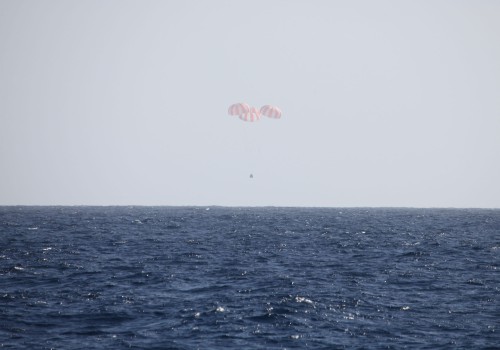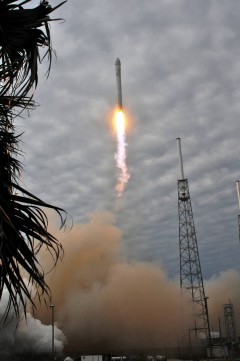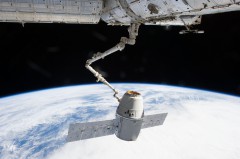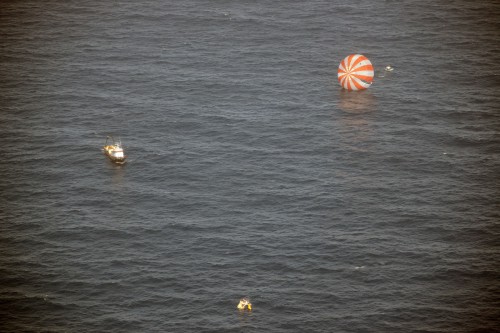
Less than a month after its rousing launch from Cape Canaveral Air Force Station, Fla., SpaceX’s CRS-2 Dragon cargo ship was today recovered from the waters of the Pacific Ocean. Early indications suggest that the commercial spacecraft’s unberthing and release from the International Space Station, followed by three burns of its Draco thrusters, the de-orbit burn, and the descent itself, proceeded without incident. Recent tweets from SpaceX CEO Elon Musk also indicate that the 2,668 pounds of science payload returned from the space station is intact, although it will be several days before detailed NASA examinations at the Johnson Space Center in Houston, Texas, verifies this.
Originally scheduled to occur yesterday, the return of CRS-2—which represents SpaceX’s second dedicated cargo mission under a $1.6 billion Commercial Resupply Services contract with NASA—was postponed by 24 hours, due to predicted high seas in the primary splashdown zone, off the western coast of Baja California. Early this morning, Expedition 35 Commander Chris Hadfield and Flight Engineer Tom Marshburn, based inside the space station’s multi-windowed cupola, oversaw the intricate procedure to unberth Dragon from the nadir (Earth-facing) port of the Harmony node. Physical separation of the cargo craft from the node occurred at 4:10 a.m. EDT (8:10 a.m. GMT), with Dragon firmly in the grasp of the station’s Canadarm2 robotic arm. Marshburn gingerly maneuvered Dragon to a release position, about 30 feet “below” the ISS, and the two vehicles finally parted company at 6:56 a.m. EDT (10:56 a.m. GMT).

Backdropped by spectacular views of Earth, SpaceX’s baby then proceeded to execute a pair of burns of its Draco maneuvering thrusters to depart the vicinity of the space station. Both burns were complete within a few minutes of release and a third burn at 7:07 a.m. EDT (11:07 a.m. GMT) finally pushed the cargo craft beyond the boundaries of the Keep-Out Sphere, a collision-avoidance zone which extends approximately 200 meters around the ISS. After passing this point, SpaceX—the Hawthorne, Calif.-based organization responsible for building both Dragon and its launch vehicle, the Falcon 9—assumed primary control for the impending return to Earth. In the meantime, aboard the station, Hadfield and Marshburn completed the safing of Canadarm2 after a job well done.
Despite a troubled start, CRS-2 has proven a remarkable success and an indicator that, once again, SpaceX can rebound from real-time difficulties to accomplish its primary goals. Last October, the CRS-1 mission’s Falcon 9 booster experienced an engine-out anomaly, 80 seconds after launch, which doomed a small “piggyback” Orbcomm satellite, yet still provided the impetus to deliver Dragon to the International Space Station. Then, in the minutes following the launch of CRS-2 just three weeks ago, on 1 March, a glitch occurred with Dragon’s maneuvering thrusters which threatened to ruin the mission. Within hours, however, the hard work of SpaceX controllers remarkably reversed CRS-2’s fortunes and a triumphant berthing with the space station was concluded on 3 March.

The ten-minute de-orbit burn, which commenced today at 11:40 a.m. EDT (3:40 p.m. GMT), demonstrated that the troubleshooting associated with the Draco thrusters had worked. Shortly afterwards, the pressurized capsule—laden with 2,668 pounds of scientific samples from human research, biology and biotechnology studies, physical science investigations, and educational activities—and its unpressurized Trunk parted company. The latter burned up in the dense upper atmosphere, whilst the former plunged toward a splashdown in the Pacific Ocean. Dragon’s drogue parachute was deployed at 12:28 p.m. EDT (4:28 p.m. GMT), at an altitude of 45,000 feet, slowing the craft, followed by a trio of red-and-white main canopies at 12:30 p.m. EDT (4:30 p.m. GMT), at 10,000 feet. Seconds later, the first visual sighting of the spacecraft was made by the crew of the recovery vessel, American Islander. On hand to receive Dragon were tracking gear, a team of engineers and technicians, a full diving team, and a large A-frame to lift the capsule from the water.
Splashdown was confirmed at 12:34 p.m. EDT (4:34 p.m. GMT), several hundred miles off the western coast of Baja California, and SpaceX was among the first to announce success on its Twitter page. The organization has now supported three Dragon missions in less than a year, whilst fellow award-winner in the Commercial Resupply Services contract—Orbital Sciences Corp. of Dulles, Va.—has yet to test-launch its Antares booster, much less fly a demo mission of its own Cygnus cargo craft to the ISS. As a result, SpaceX is the United States’ only home-grown vehicle, launched from home soil, with the capability to transport payload to and from the International Space Station. Two thousand pounds of payload is a far cry from the enormous payload capacity of the shuttle, but coming from a commercial concern the accomplishments of SpaceX cannot be underestimated.
“The scientific research delivered and being returned by Dragon enables advances in every aspect of NASA’s diverse space station science portfolio, including human research, biology, and physical sciences,” said ISS Program Scientist Julie Robinson. “There are more than 200 active investigations underway aboard our orbiting laboratory in space. The scientific community has eagerly awaited the return of today’s Dragon to see what new insights the returned samples and investigations it carries will unveil.”

Among the returned investigations was the Coarsening in Solid-Liquid Mixtures (CSLM)-3 experiment, which also launched to space aboard this Dragon. CLSM-3 studies how crystals known as dendrites form as a metal alloy becomes solid. The research could help engineers develop stronger materials for use in automobile, aircraft, and spacecraft parts. Current projections are that Dragon will be transferred to port, near Los Angeles, and thence returned to SpaceX’s test facility in McGregor, Texas. Whilst most of the payload will be subsequently sent to NASA’s Johnson Space Center in Houston, there are plans for the time-critical biological samples—including those aboard a General Laboratory Active Cryogenic ISS Experiment Refrigerator (GLACIER)—to be returned to NASA “within 48 hours.”
Dragon transported a wide variety of payloads to the space station, including the first dedicated occupant of its unpressurized “Trunk”: a pair of Heat Rejection Subsystem Grapple Fixtures (HRSGFs)—nicknamed “grapple bars”—which will be installed on the outboard S-1 and P-1 trusses in July, during a pair of EVAs by Expedition 36 crewmen Chris Cassidy and Luca Parmitano. The bars will support the future repair or replacement of ISS radiators. Also aboard the commercial vehicle’s pressurized section were two GLACIERs, a space electronics box for a Minus-Eighty-Degree Laboratory Freezer for ISS (MELFI), a carbon dioxide removal assembly, and general crew provisions, including fresh foodstuffs. The mission was the second of at least 12 resupply flights to be made by SpaceX by 2016.



